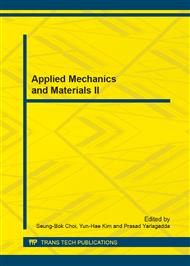p.620
p.624
p.631
p.635
p.640
p.646
p.651
p.655
p.660
Redistribution of Internal Force under Structural Defect and Non-Linear Spatial Stability under Live Load and Wind of Tied-Arch Bridge
Abstract:
To study the mechanical performance and stability of tied-arch bridge under structural defects and damages, limited element modal of Panzhihua Luoguo Jinshajiang Bridge was established and analyzed. Firstly, some typical damage models and their influence factors were presented. Then, based on the model established, change of suspender force caused by arch rib lineation defect, hanger lineation defect and boom failure was calculated respectively. The stability safety factor under the load group composed of dead load, live load and wind was calculated as well as the second-class nonlinear stability safety factor under structural initial defect. Calculation results shows that, suspender forces were more sensitive to archs vertical defect than to transverse defect. While, short hangers were more sensitive to lineation defect than long ones, and secondary inner force in short booms were bigger than in long ones. The result also tells that lateral wind is bad to lateral stability. Lift wind, somehow, makes positive contribution to structures in-plane stability. Structural initial defect can draw down the second-class stability safety factor under geometric nonlinear condition.
Info:
Periodical:
Pages:
640-645
Citation:
Online since:
December 2013
Authors:
Price:
Сopyright:
© 2014 Trans Tech Publications Ltd. All Rights Reserved
Share:
Citation:


